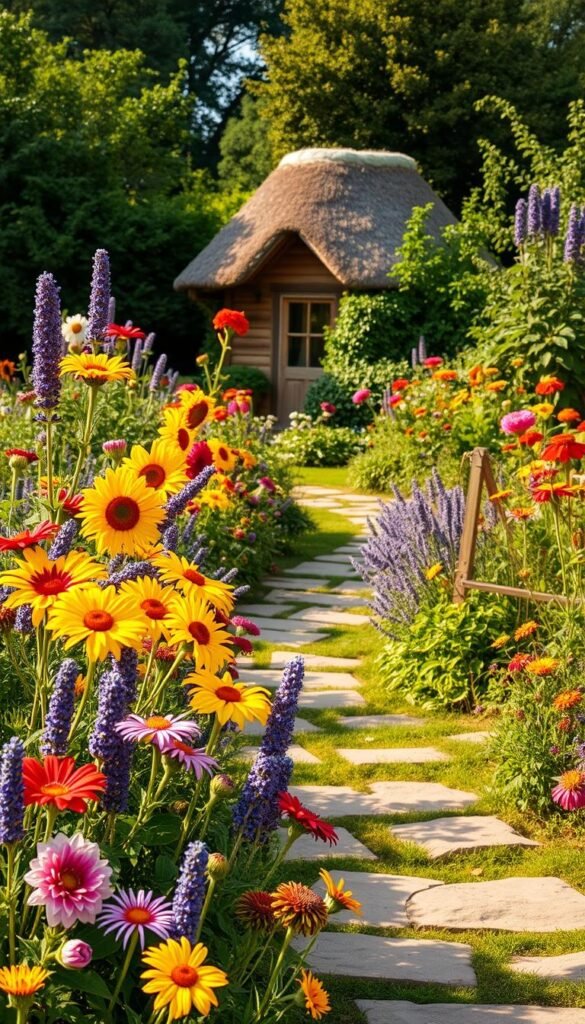Imagine stepping into a space where wild charm meets intentional design—a place buzzing with life, color, and fragrance. Cottage gardens thrive on this balance, blending carefree beauty with practical purpose. Unlike formal landscapes, these whimsical spaces invite you to embrace nature’s spontaneity while creating a sanctuary right outside your door.
What makes these gardens unique? Think winding pathways, clusters of blooms, and a joyful mix of herbs, vegetables, and flowers. This style skips rigid rows in favor of dense plantings that feel alive and ever-changing. Direct sowing seeds works perfectly here, letting plants grow where they naturally thrive. It’s like painting with nature’s palette!
Beyond aesthetics, cottage gardens serve your home and lifestyle. Snip fresh blooms for your kitchen table or harvest herbs for dinner—all while enjoying a space that evolves with each season. The magic lies in its flexibility: beginners appreciate its forgiving nature, while seasoned growers love the creative freedom.
Ready to rethink traditional gardening? It starts with celebrating imperfection. Let plants spill over paths, allow self-seeding surprises, and watch your landscape transform into a living masterpiece. Whether you’re planting your first bed or refreshing an existing space, the journey from seed to bloom becomes its own reward.
Embracing the Cottage Garden Aesthetic
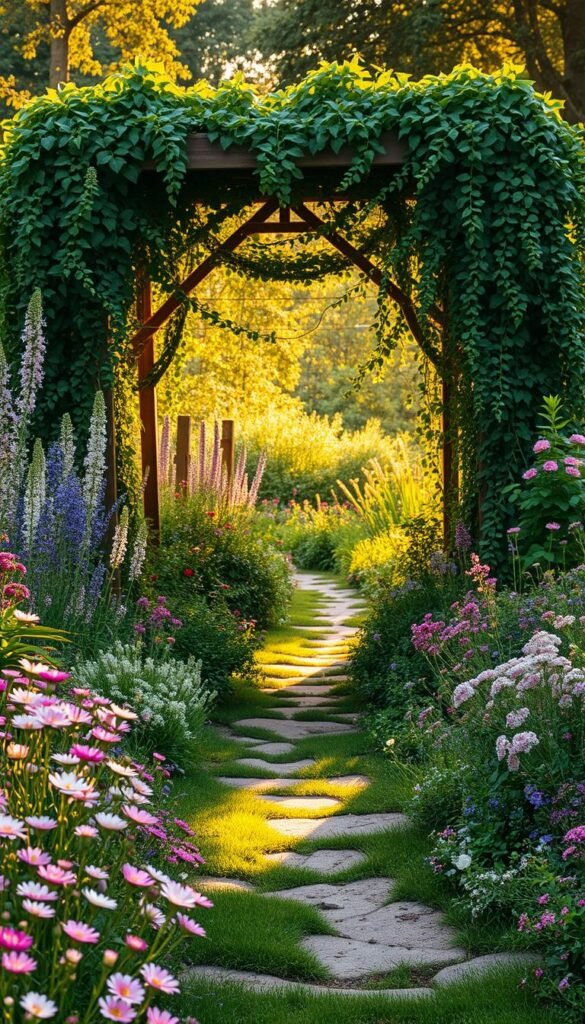
Picture a landscape where romantic chaos dances with thoughtful design—a place where vibrant colors tumble over weathered fences and stone paths invite exploration. This is the heart of cottage garden style, blending playful spontaneity with timeless appeal.
Understanding the Charming, Whimsical Style
Traditional cottage gardens thrive on “organized wildness.” Instead of strict symmetry, you’ll see foxgloves leaning toward lavender and daisies mingling with thyme. Curved pathways made of gravel or reclaimed bricks encourage leisurely strolls, while self-seeding plants create delightful surprises each year.
Incorporating Traditional English Elements
Key features like climbing roses framing doorways or hollyhocks standing sentry by gates anchor the cottagecore aesthetic. Mix practical herbs like sage among peonies for texture, and let sweet peas scramble up obelisks. These choices soften architectural lines and create color layers that shift with the seasons.
For curb appeal, position taller blooms like delphiniums near your home’s foundation. Add a rustic bench or vintage watering can to enhance the fairytale charm. Remember: the goal isn’t perfection—it’s creating a garden that feels alive, welcoming, and deliciously imperfect.
Designing Your Garden Layout for Year-Round Blooms
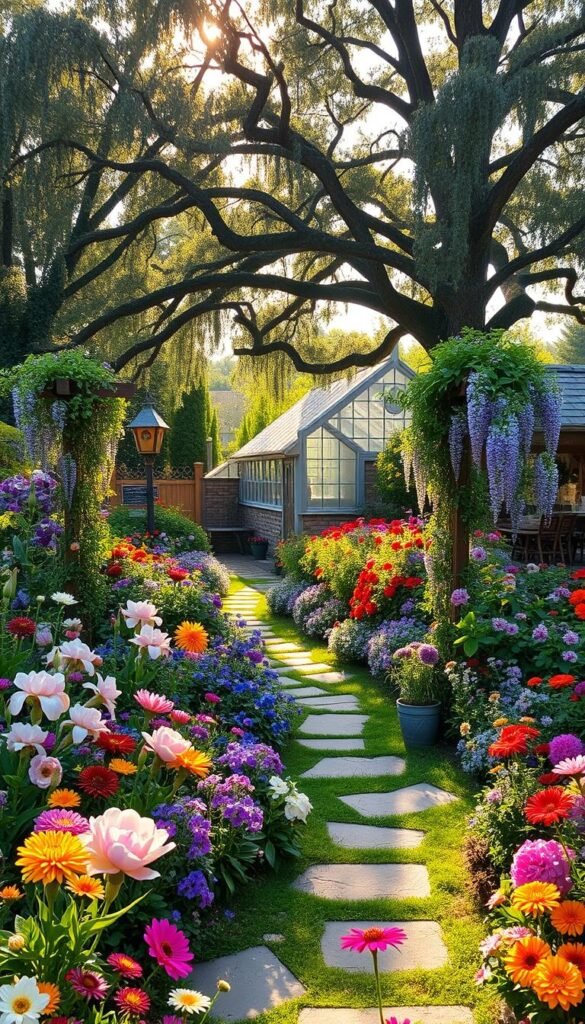
Transform your yard into a living tapestry that delights every season. Strategic layout choices ensure your space bursts with color from spring frosts to autumn’s first chill while keeping maintenance manageable.
Planning Your Pathways and Planting Beds
Begin by sketching winding gravel paths that hug your home’s architecture. These curved walkways create natural flow while defining planting zones. Use this simple rule for bed arrangements:
| Plant Height | Placement | Example Plants |
|---|---|---|
| 6-12″ | Path edges | Thyme, Alyssum |
| 1-3′ | Middle beds | Shasta Daisies, Sage |
| 4’+ | Back borders | Hollyhocks, Sunflowers |
Map your yard’s microclimates before digging. Sunny south-facing areas suit roses and tomatoes, while ferns thrive in shaded north corners. Leave 18″ between beds for easy access.
Selecting the Right Flowers and Vegetables
Mix 70% perennials like coneflowers with 30% annuals like zinnias for constant blooms. Tuck edible plants into floral displays—try purple basil beside lavender or rainbow chard near cosmos. This blend creates productive beauty that feeds both body and soul.
Remember: cottage gardens improve with age. Let plants self-seed freely, and don’t panic if mint invades your marigolds—that’s part of the charm!
From Seed to Bloom: Nurturing a Cottage Flower Garden Over the Seasons
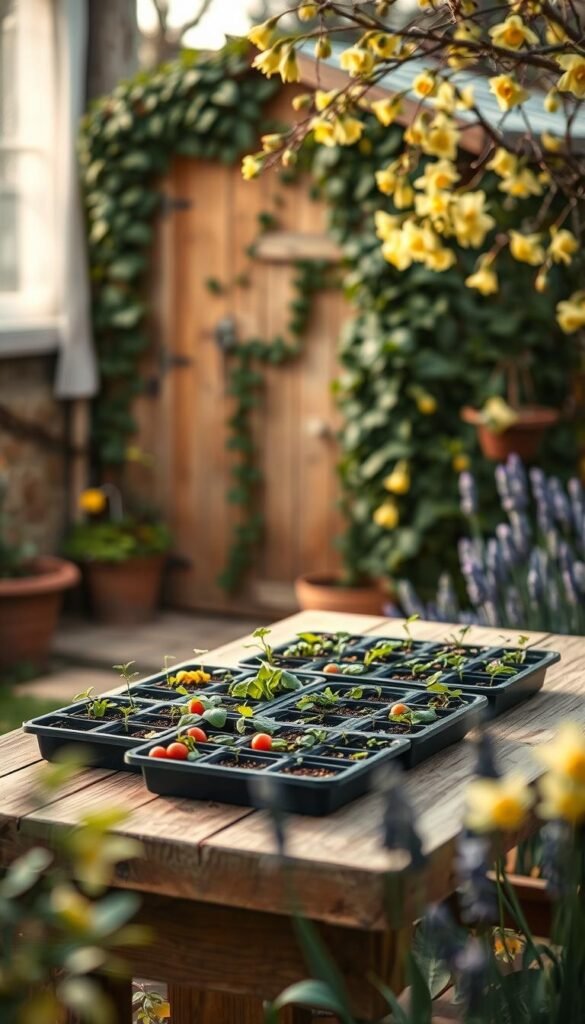
Crafting a vibrant cottage garden begins with one magical act: tucking seeds into soil. Timing matters most. Wait until after your spring frost date—check local agricultural extensions for precise dates—then let the planting party begin!
Step-by-Step Guide to Starting from Seeds
Scatter taller varieties like sunflowers and snapdragons along fences or back borders. Front edges suit shorter stars: calendula and marigolds create cheerful borders. Pro tip: mix sand with tiny seeds (like chamomile) for even distribution.
Many beginner-friendly flowers thrive when direct-sown. Try this schedule:
- Early spring: Poppies & bachelor buttons
- Late spring: Zinnias & cosmos
- Summer: Quick-blooming marigolds (harvest in 8 weeks)
Essential Planting Tips for Long-Lasting Blooms
Loosen soil 12″ deep before planting. Press seeds gently into earth—most need darkness to sprout. Keep soil moist using a fine mist sprayer until seedlings emerge.
Petunias deserve special care: start indoors 8 weeks before last frost. Transplant seedlings when nights stay above 50°F. For non-stop color, sow new batches every 3 weeks. Those July-planted sunflowers? They’ll tower over pumpkins come October!
“Seeds carry infinite potential—your care unlocks their floral fireworks.”
Remember: cottage gardens reward experimentation. If one variety struggles, three others will thrive. Keep notes, adjust timing yearly, and let your garden grow wilder each season.
Seasonal Care, Watering, and Pest Management
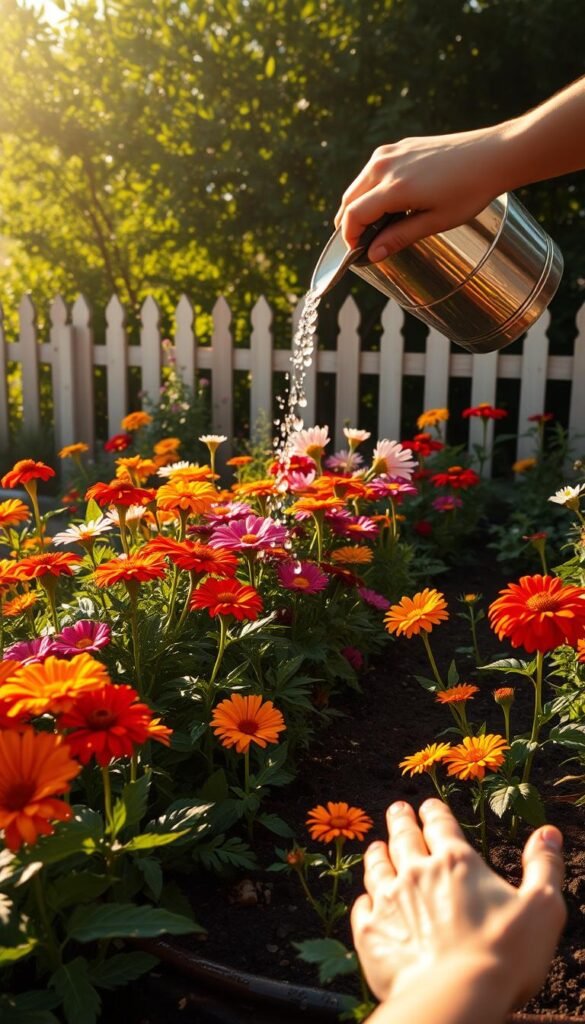
Your cottage garden’s success hinges on adapting to nature’s rhythms—watering wisely, outsmarting pests, and dancing with seasonal shifts. Let’s break down the essentials for keeping your plants thriving from spring’s first sprouts to autumn’s final hurrah.
Effective Watering Strategies and Timing Adjustments
New seeds demand daily attention. Water lightly twice a day for the first week, keeping soil moist but not soggy. As roots grow deeper, shift to longer soaks every 2-3 days. Mature plants thrive with weekly deep watering. Miss a single day during germination? Those seeds won’t sprout.
| Stage | Frequency | Duration | Plant Stage |
|---|---|---|---|
| 1 | Twice daily | 5 minutes | Seed germination |
| 2 | Every other day | 10 minutes | Seedling growth |
| 3 | Weekly | 20 minutes | Established plants |
Natural Pest Control and Garden Maintenance
Snails adore marigold seedlings. Apply pet-safe bait when planting and refresh every 10 days. For aphids, blast them off with water or release ladybugs. Cut flowers often—zinnias and cosmos bloom more when trimmed weekly. Bonus: you’ll always have fresh bouquets!
Adapting Your Care Techniques as the Seasons Change
Summer heat calls for early morning watering to prevent evaporation. Come fall, reduce irrigation as plants prepare for dormancy. Sweet peas need extra support—train vines up trellises using soft twine. Remember: healthy plants from last year often reseed themselves, giving you free volunteers!
“A garden’s needs change like the weather—stay observant, stay flexible.”
Rotate pest control methods each season to avoid resistance. Clear spent blooms regularly to encourage new flower production. With these strategies, your cottage oasis will flourish through every phase of the growing season.
Bringing Your Garden Dreams to Life
Your cottage garden journey evolves with each season, blending timeless beauty with practical rewards. Start by anchoring your space with perennials like lavender and yarrow—these hardy favorites return stronger yearly, forming a low-maintenance backbone. Interplant them with cheerful annuals like cosmos or nasturtiums for pops of seasonal color.
Mix edible and ornamental plants for double-duty charm. Tuck rosemary beside roses or let lemon balm cascade over pathways. Pollinators flock to these combos, turning your colorful container gardening spots into buzzing hubs. Harvest thyme for roasted veggies or snip sunflowers for summer bouquets—every corner serves a purpose.
As years pass, your garden grows wiser. Marjoram spreads near leeks, while hollyhocks tower over new garden beds. Experiment freely: try Damask roses one season, then swap in fragrant hops the next. Each addition deepens your landscape’s character and productivity.
Remember—great gardens aren’t built in a day. Let perennials establish roots, welcome self-seeded surprises, and watch your outdoor sanctuary flourish. With patience and playfulness, you’ll craft a living masterpiece that nourishes both home and heart.

